For many of us, there is no summer without tomatoes.
When you’re sowing tomato seeds, you’re sowing summer!
And sigh: Growing gorgeous tomato transplants from seed is *not* especially easy.
Here’s the counter-intuitive truth: Younger, unstressed transplants often yield many times the abundance of old, stressed transplants.
No matter how short your seasons are, starting seeds earlier than is optimal is simply undermining your abundance.
Also, your goal for any transplant (also potentially counter-intuitive!) is for your seedling to be as short, stout & deep green as possible. Short and stout because they’re not leggy, stretching and stressed for light. Deep green because they’re fully photosynthesizing and not nutrient-deficient.
Growing healthy tomato transplants is not easy, Friends.
Being honest with ourselves about how well we grow transplants indoors is even harder!
Here are common mistakes to save you heartache as well as how to sow your own tomatoes, peppers and eggplant from seed to surround yourself with abundance!
It’s counter-intuitive, but younger seedlings are often more abundant than older seedlings, simply because they’re often less stressed.
Common Mistakes to Avoid
Mistake: Seeds sown too soon
Solution: Sow tomatoes, peppers and eggplant indoors 6 to 8 weeks before final frost. Check out our transplant chart below! Here in Zone 5, we sow in the first week of April, ~8 weeks before final frost. If you don’t have a grow light, start two if not three weeks later — and still be prepared to face the fact that your seedlings may well be stressed for light and less abundant as a result.
If you’d love to dig into transplanting timing more, enjoy our transplanting chart below to surround you with abundance, no matter the Zone you grow, head over to Fruition’s free Growing Library here:
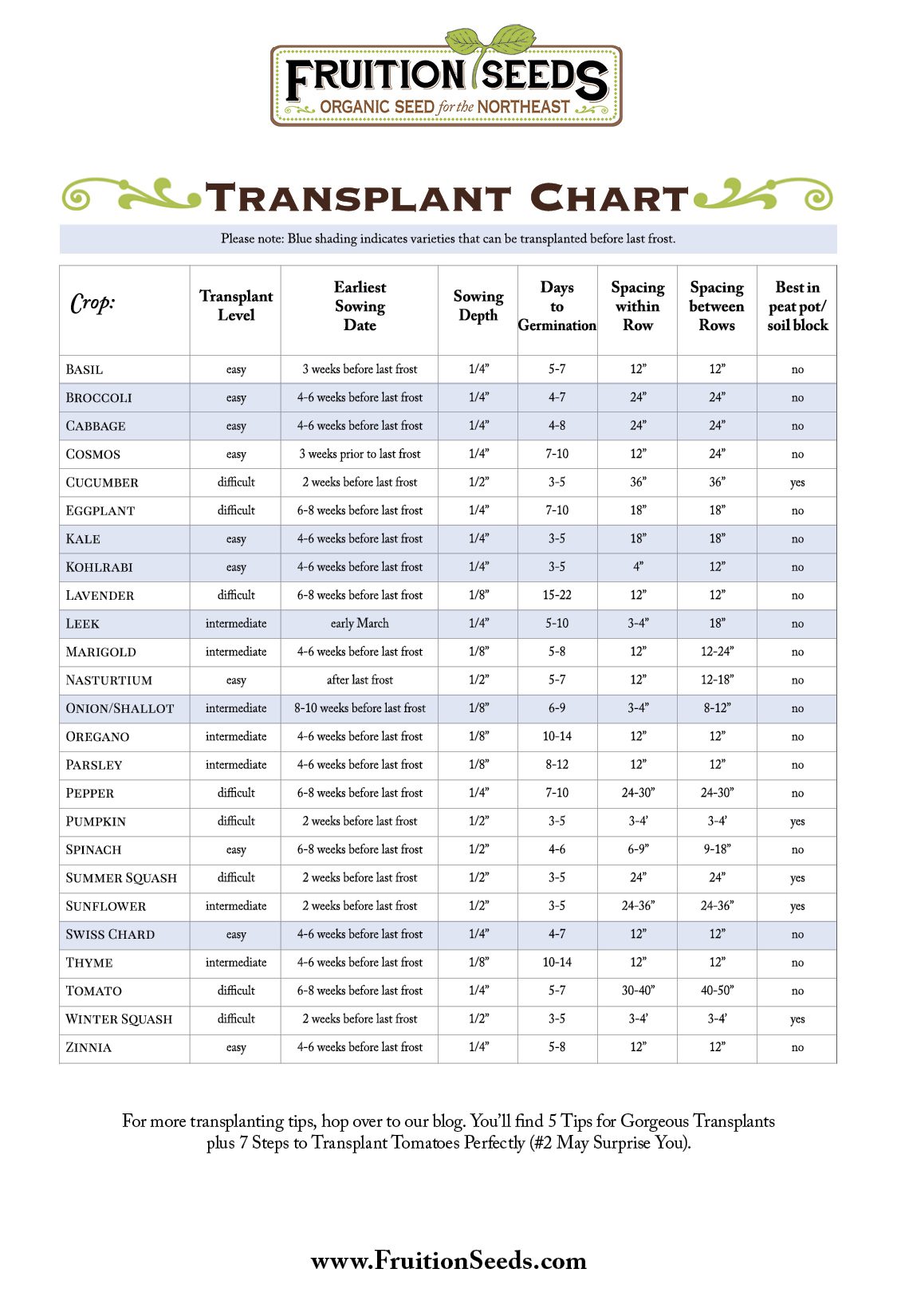
Mistake: Seeds sown too deep
Solution: As a general rule, seeds are best sown twice their depth, which isn’t very deep. Most people bury their seeds much too deeply, making germination much more difficult for their seeds.
Whether you’re sowing indoors or out, most seeds are best sown at twice their depth and tomatoes are no exception!
Mistake: Not enough heat for good germination
Solution: Tomatoes, peppers and eggplant are tropical plants, germinating best in more tropical temperatures than most of us live in. Most seeds, including these, germinate best between 75 and 80 F. Since this is notably warmer than our homes, heat mats make all the difference. Heat mats raise the temperature of your soil 15 to 18 F above the ambient air around them. We share ours here!
Not ideally but alternatively, place your germinating seeds in the warmest place in your home. The top of your fridge might surprise you!
Mistake: Not enough light for a healthy growth
Solution: Plants photosynthesize sunlight into sugar, but only the red and blue wavelengths and seedlings need a lot: 16 to 18 hours each day! If you don’t have a grow light, your best bet is to joyfully commit to finding gorgeous organic transplant when final frost approaches. If you’re looking for such a grow light, we share our full-spectrum LED lights here.
Real grow lights like our full-spectrum LED make all the difference.
Mistake: Not potting up quick enough
Solution: Pot up early and often, Friends! Your goal with any transplant is to grow the healthiest plant possible. Short and stout is healthier than tall and gangly! For more details on potting up well, read on.
7 Steps to Sow Gorgeous
Tomatoes, Pepper & Eggplant Seedlings
1. Gather Materials
~ Seeds
Seeds well-adapted for your Zone are always more abundant than seeds selected for other Zones. You’ll find our organic seeds for short seasons here! Regional adaptation is especially important for tomatoes, peppers and eggplant, because their need for warmth, light and susceptibility to disease makes regional adaption essential.
Most seeds are best sown at twice their depth and tomatoes are no exception!
As a general rule, seeds selected for shorter seasons thrive in longer seasons better than the opposite. And keep in mind most seed companies are not growing seed (they’re simply re-selling seeds on the wholesale market), so be sure to ask your regional seed companies where their seeds are grown. A few of our favorites are Uprising Seeds (WA), Siskiyou Seeds (OR), Adaptive Seeds (OR), Wild Garden Seeds (OR), Redwood Seeds (CA), Common Wealth Seeds (VA) and True Love Seeds (PA). In Canada, we love Hawthorn Organic Seeds (ON), Tourne Sol Seeds (QC), Patrice Fortier (QC) and Annapolis Seeds (NS). There are so many more! Enjoy the hunt for your closest regional seed company.
~ Potting mix & tub
Rich, nutrient-dense potting mix is best for all seedings and especially for tomatoes, eggplant, pepper and any transplant living indoors more than 4 weeks. It’s worth spending a little more money for a lot better plants! We share our organic compost-based potting mix as well as our DIY potting mix minerals which makes 80 quarts of easy to make, super economical and incredibly rich potting mix and is particularly ideal for soil blocking!
A rich potting mix makes all the difference — this is not the place to skimp for your seedlings!
If you’re soil blocking, potting mixes high on coconut coir/peat moss allow for compression while maintaining ideal lightness for seedings. We use both of our mixes above to grow over 10,000 seedlings in soil blocks each season.
~ Water
Warm water is much more lovely to work with than cold <3
~ Container
There are as many ways to start seeds as there are gardeners! Soil blocking is our favorite way to start seeds by far, growing the healthiest transplants we’ve ever seen. Mini-blocks are ideal for starting heat-loving tomatoes and other solanids as well as slow-to-germinate seeds like thyme, lavender and so many other flowers and herbs.
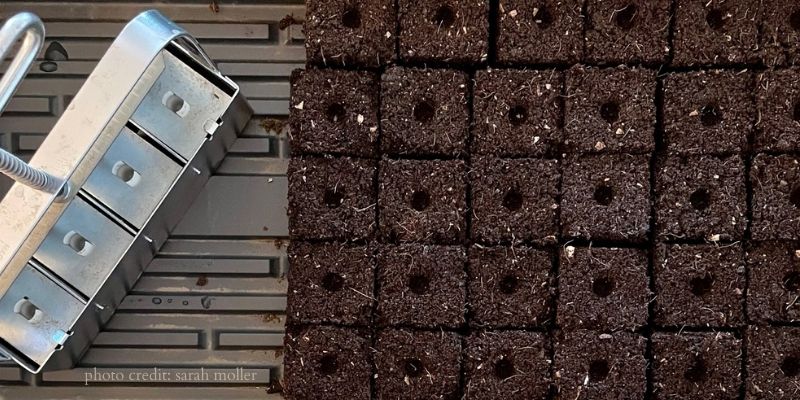
Soil blockers are by far our favorite way to start seeds. Our seedlings never become root-bound and you’ve eliminated single-use plastics from your seed starting!
Beyond soil blocks, cell trays and six-packs are a great second choice. We also love cow and peat pots to pot up tomatoes, peppers and eggplant as they grow.
Though we rarely dissuade folks from doing what they love, please refrain from using egg cartons or jiffy pots for starting your seeds. Egg cartons don’t hold much potting mix and their curvaceous sides make transplanting without disturbing roots impossible. Jiffy pots are a fabulous idea, but the potting mix inside is generally low quality. Pay no attention to Pinterest! I beg you!
Keep in mind that your containers need to drain and somehow not make a mess in doing so! A ‘top tray’ with holes paired with a ‘bottom tray’ without holes goes a long way. Bottom trays of all sizes can be found at garden centers, though resourceful gardeners will find lots of up-cycled materials around the house including cookie sheets, take-out containers and even rolls of toilet paper!
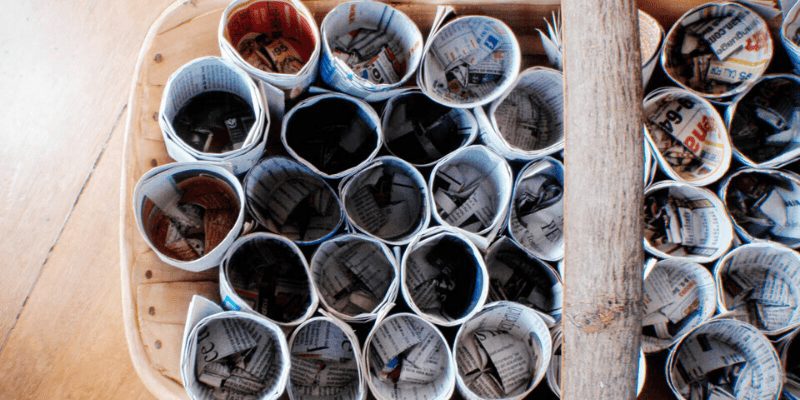
Resourceful gardeners are the BEST! Thanks to our friend Melissa who inspired us to try using take-out containers as trays for soil blocks as well as cut pieces of toilet paper rolls
~ Label & waterproof marker
Oil-based markers are waterproof, resisting smearing or fading even as the weeks turn into months. We love resourceful gardeners who use popsicle sticks, cut up yogurt containers, old blinds or other up-cycled materials they find in their homes!
(optional yet optimal:)
~ Heat mat
Most seeds germinate best between 75 to 80 F, much warmer than most of us heat our homes. Heat mats efficiently make up the difference, raising the soil temp 10 to 15 F above ambient air temperature. If you don’t have a heat mat, find the most consistently warm place in your home to germinate your seedlings. The top of your fridge might surprise you! A dark place isn’t ideal but is totally possible — just monitor their emergence every day, as often as you can, and the moment the first seedling emerges, transition the tray to the best light possible.
All seeds germinate more quickly on a heat mat, but for tomatoes, peppers and eggplant, a heat mat makes all the difference.
~ Grow light
Abundant, high-quality light is often the biggest limiting factor for people growing tomatoes, peppers & eggplant seedlings in their home. Plants only photosynthesize red and blue wavelengths, so not all lights are adequate to grow healthy plants. Each year we receive hundreds of emails sharing photos of pale, leggy seedlings leaning toward any light they can find, often in the opposite direction of the fluorescent light 5″ above them! And it breaks our hearts.
We share 17″ full-spectrum LED grow lights made by our friend Vic in Illinois. He grows tomatoes all winter with them indoors! Each light comes with a timer; 18 hours of light each day is optimal for seedlings with the LED light 6″ above their leaves.
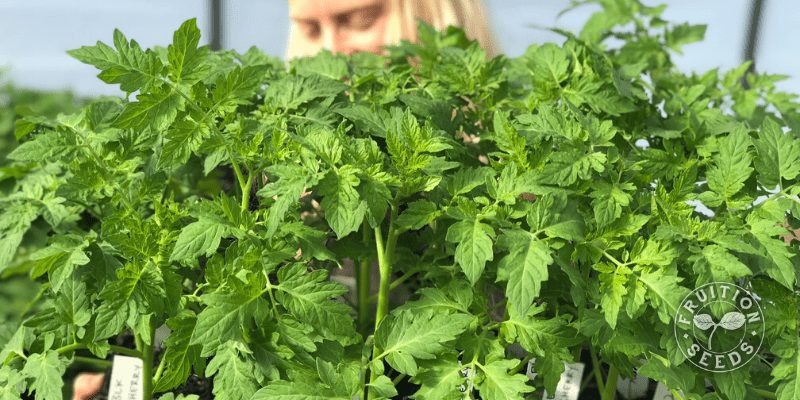
Great light makes all the difference, whether it’s from the sun or from a high-quality grow light.
~ Take notes!
We are constantly experimenting, refining and learning things the hard way! Taking good notes is one of the best ways we bring more joy as well as organization to our days. There are as many approaches to note-taking as there are note-takers; our Across the Seasons perpetual calendar is an easy and awesome way to plan your garden, track your abundance and amplify your future abundance! As well as record when the Indigo Buntings return!
In early April, we noted when we planted peas outdoors, tomatoes indoors and when the Eastern Phoebe returned in our Across the Seasons perpetual calendar!
2. Fill Containers (or Make Your Own Soil Blocks!)
If you’re using cell trays or other vessels, gently tamp them on the surface you’re working on to settle your potting mix, removing large air pockets so your seedlings can enjoy the most nutrients possible.
If you’re making soil blocks, be sure they’re as sturdy as possible.
3. Sow Your Seeds — Just Not Too Many
Hooray! We’re finally sowing seeds!
Sow only 1 to 2 seeds per cell or soil block, Friends. If your seeds have extraordinary germination and are packed for that season, 1 seed is optimal. If your seeds are older or you’re otherwise not confident of their germ, sow 2 to 3 seeds per cell or soil block. Your goal is to have 1 healthy seedling per cell or soil block with minimal thinning, which requires your time and energy as well as subjects your seedlings to unnecessary competition both above and below the soil.
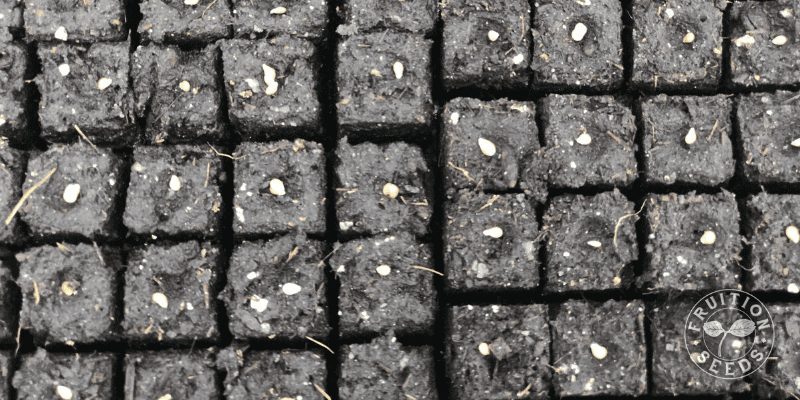
If your seed is high quality, one seed per cell or soil block optimizes your time and energy as well as your seedling health.
4. Cover Your Seeds — Just Not Too Much
As a general rule, sow seeds twice their depth.
Sowing seeds too deep is too easy!
Sown too deep, seeds take longer to germinate and their stress increases, reducing their overall vitality and resilience.
Gently press your freshly sown seeds with just a touch of moist potting mix, ensuring full soil-seed contact. This surrounds your germinating seeds with ample water and nutrients as soon as they emerge.
5. Label Your Seeds
We label our seedlings with both variety name and date, making it easier to stay organized and adapt effectively.
I’ve learned to even label our cells and soil blocks before sowing them, just to keep them that much more organized!
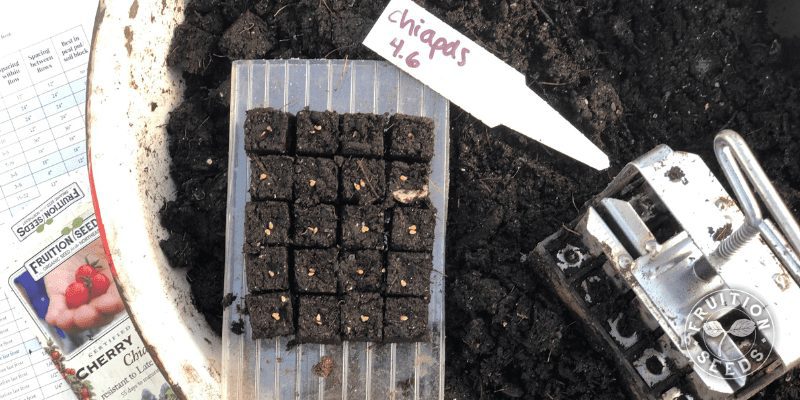
Label your seedlings with both variety name and sowing date. Your future self will likely thank you!
Oil-based markers are waterproof, resisting smearing or fading even as the weeks turn into months.
We love resourceful gardeners who use popsicle sticks, cut up yogurt containers, old blinds or other up-cycled materials they find in their homes!
6. Straight Talk on Warmth & Light
Tomatoes, peppers and eggplant are tropical plants that desire abundant warmth and light, the more the better, every moment of their lives. Germination is no exception. Heat mats and high quality grow lights make all the difference.
If you don’t have a heat mat or grow light, the chances your seedlings will become stressed is much, much greater. In this case, start them no earlier than 5 weeks before final frost. A younger, less stressed transplant often yields much greater abundance than an older, more stressed transplant.
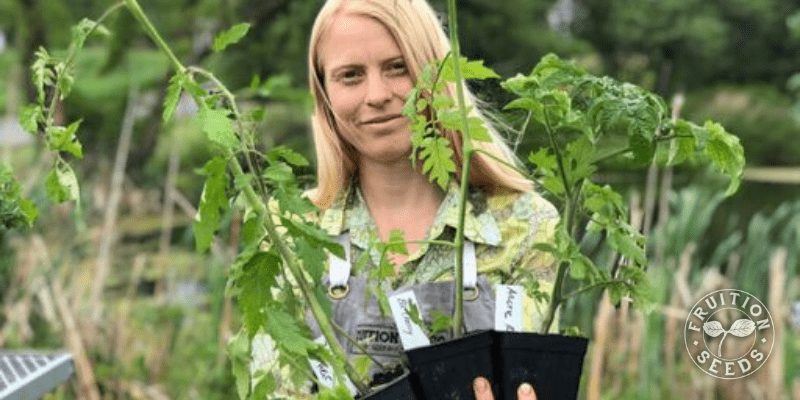
From left to right, only the right plant got enough light and will yield most abundantly, as well.
If you don’t have a heat mat, find the most consistently warm place in your home to germinate your seedlings. The top of your fridge might surprise you! A dark place isn’t ideal but is totally possible — just monitor their emergence every day, as often as you can, and the moment the first seedling emerges, transition the tray to the best light possible.
Abundant, high-quality light is often the biggest limiting factor for people growing tomatoes, peppers & eggplant seedlings in their home. Plants only photosynthesize red and blue wavelengths, so not all lights are adequate to grow healthy plants. Each year we receive hundreds of emails sharing photos of pale, leggy seedlings leaning toward any light they can find, often in the opposite direction of the fluorescent light 5″ above them! And it breaks our hearts.
Once your seedling becomes pale and leggy, more stem than leaf, thank it for teaching you about the significance of light, send it to the compost gently and take notes. Is it timing, tools and/or techniques that you can adapt? Failure is an essential foundation of success. Recording your observations is a phenomenal way to focus on what you can do differently rather than what you’ve done ‘wrong.’
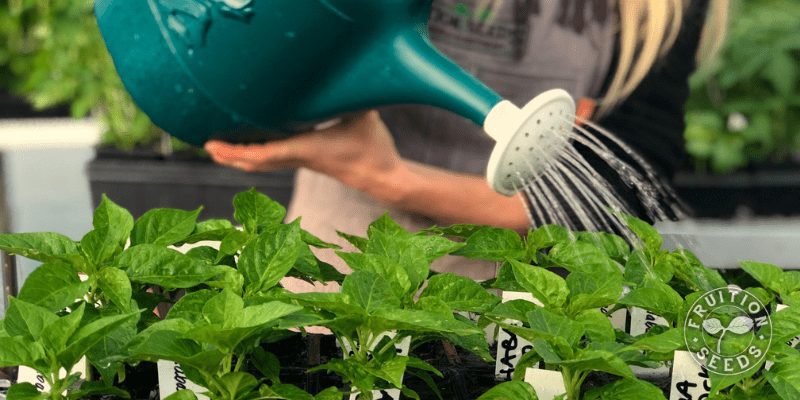
Short, stout and deep green is the goal for your transplants.
7. When & How to Pot Up Tomatoes, Peppers & Eggplant
Here are the keys:
General Rule: Pot up early and often.
Pot up mini-blocks into larger blocks once your seeds have emerged, the sooner the better.
Pot up seedlings in cell trays or large soil blocks into 3 or 4″ pots once you have one full set of true leaves.
Feed your seedlings fish emulsion once each week when they have 2 full sets of true leaves. If you’re starting to notice they’re nutrient deficient, they are! Prevention is the best cure.
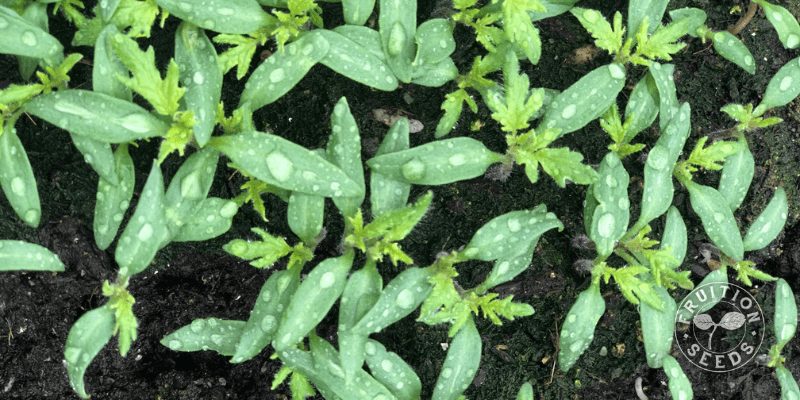
The long, narrow cotyledon leaves are just beginning to show the first set of true leaves emerging! Now is the perfect time to pot up these tomatoes.
Tomato stems can transition to roots, so they’re potted up differently than peppers, eggplant and most other garden vegetables, flowers and herbs. Bury 3/4 of your tomato stems when you pot them up, Friends! This is a phenomenal technique for any tomato and especially those who are becoming leggy.
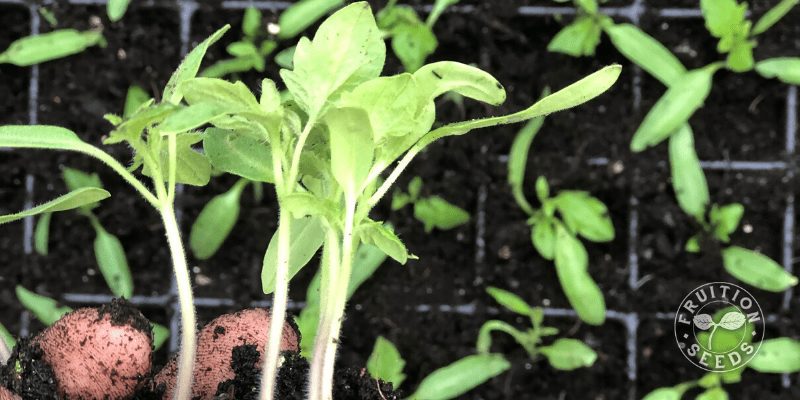
Bury the stems of any tomatoes and especially leggy seedlings: They’ll turn into roots!
Sowing and caring for the sensitive seedlings of tomatoes, peppers and eggplants is a lot of effort, to be sure.
Just like anything worth doing.
And I’m so honored to accompany you on the journey, Friends!
Sow Seeds & Sing Songs,

and the Many Beings of Fruition
ps
Just think of what we’ll be harvesting a few months from now!
pps
And to think it all begins with a seed.

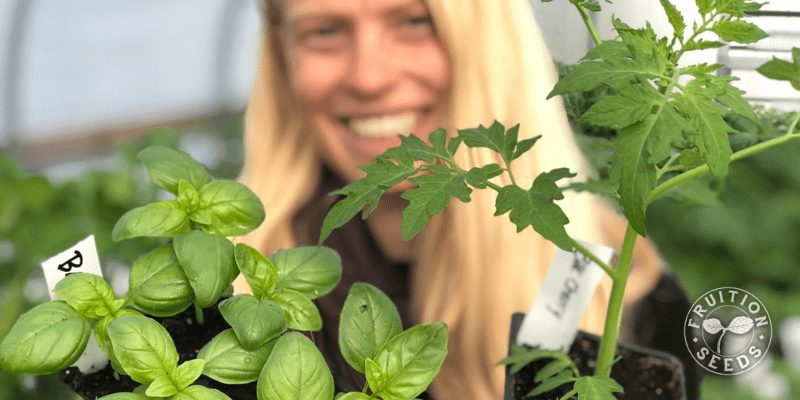
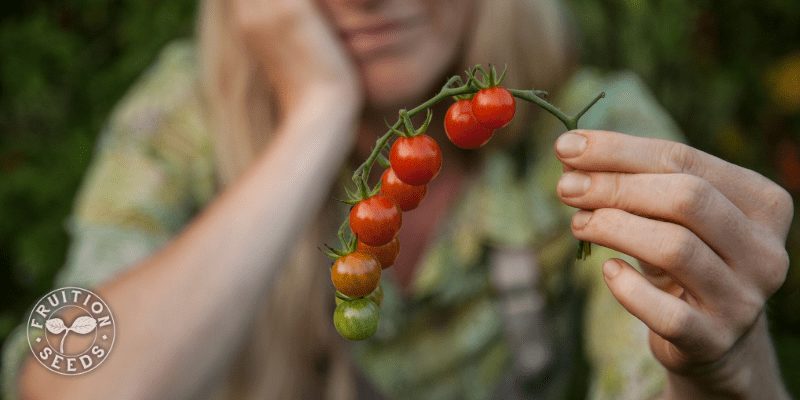
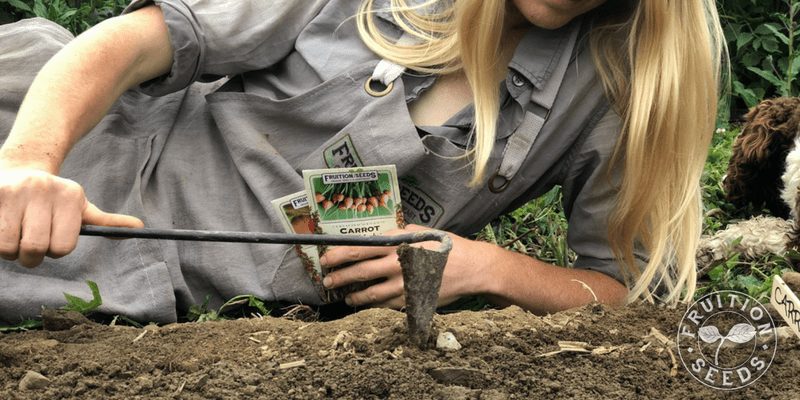
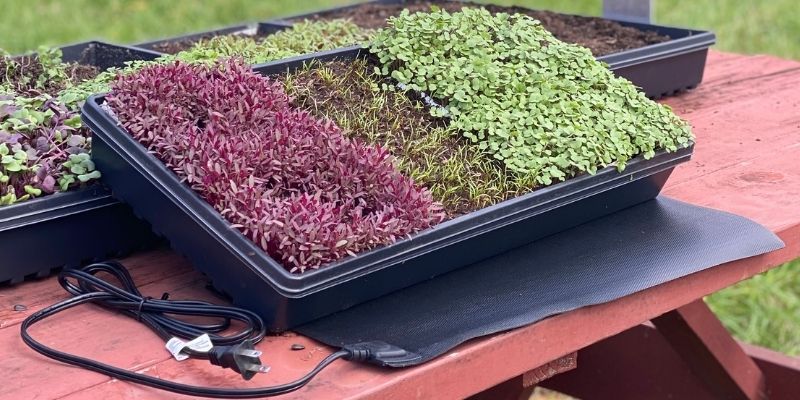
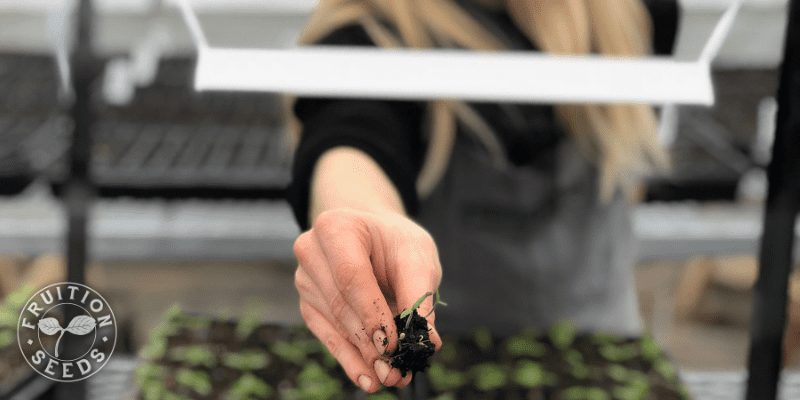
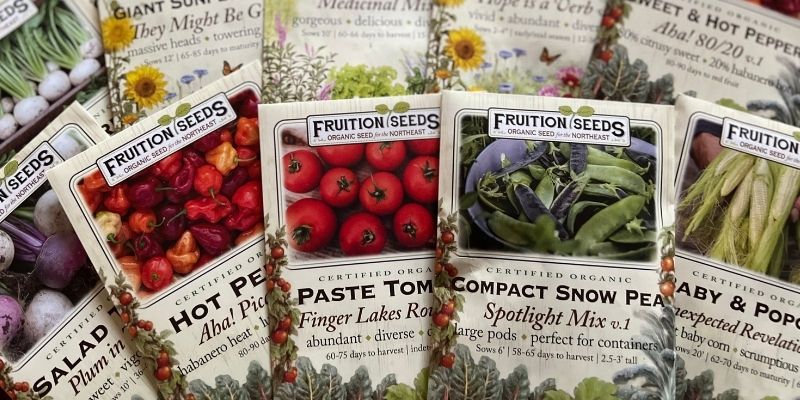
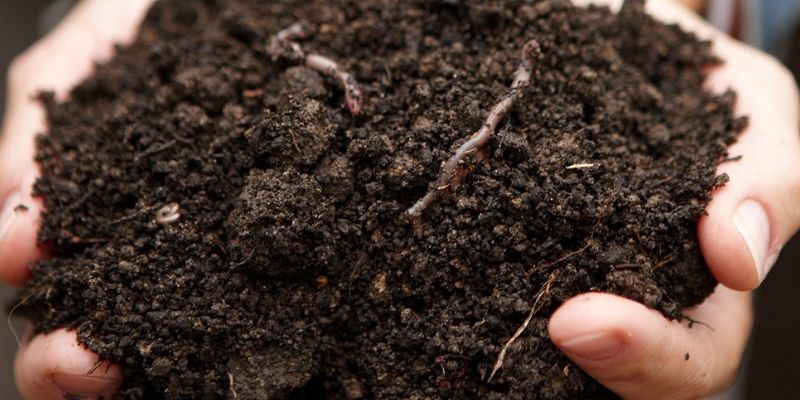
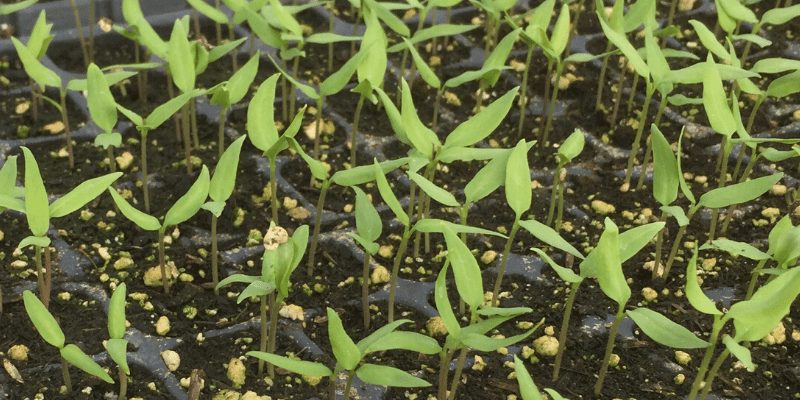
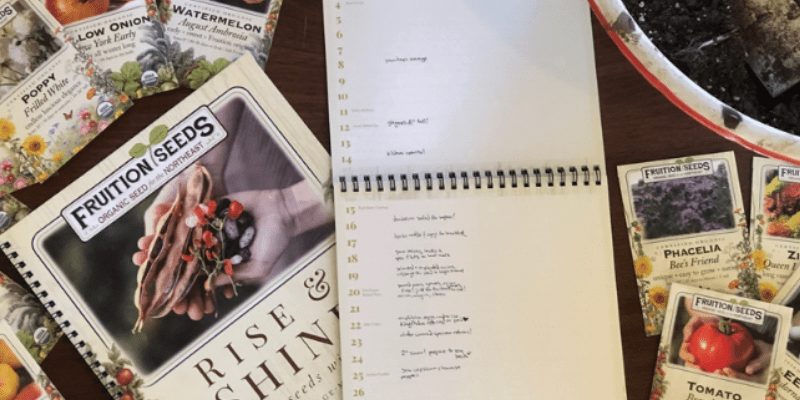
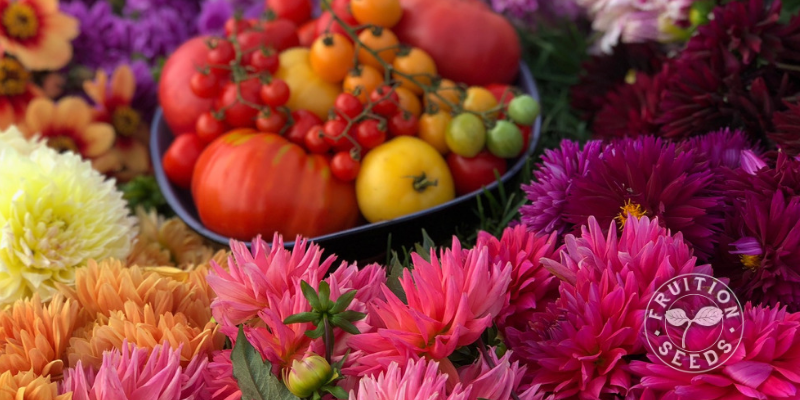
I’ve been taught to remove seedlings from the heat mat as soon as they emerge. Are you saying that tomatoes, peppers and eggplants are an exception?
Hi Cali, you have some choices and both are okay! Take a peek at this video for more info and happy sowing! https://www.fruitionseeds.com/learn/courses/growing-great-tomatoes/lessons/starting-tomato-seeds/topic/when-to-take-seedlings-off-the-heat-mat/
Love your tips, thanks! I may need to repot some of my tomatoes deeper that I did. One rule I’ve always broken but it seems to work, is that I do transplant seedlings before any true leaves appear, because often they will get too tall under the humidity dome and need to be moved sooner. The one advantage I see to this is that hardly any roots have formed yet, so you are far less likely to disturb or damage them in the transfer.
I think you meant Jiffy peat pellets rather than pots. I’m not fond of them mainly because the Tyvek-like nylon casing is so tough that roots have a hard time penetrating it. They tell you it will break down, but if you pull the plant in the Fall, there is the still completely intact casing, and maybe one or two roots got through, with many more trapped, stunted, and root-bound inside it. But I’d bought a bunch of the refill pellets before I found out I didn’t like them. So what I do is when it’s time to transplant, I carefully make a couple of cuts at the top of the casing and gently tear it off completely before putting the plant into the ground at transplant time.
Hi Julie, Thank you for sharing your experience and your insight. I do believe Petra meant peat pellets. Thanks for being a part of the fruition community!<3
Melissa